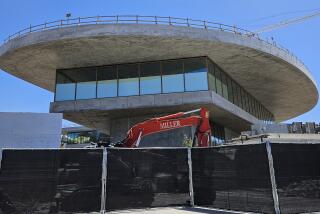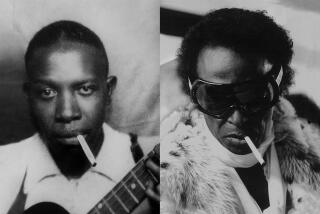COVER STORY : Museum Central : Wilshire Boulevard Collections Spur a Resurgence of Miracle Mile Area
- Share via
The doors of the old department store are opening once again to anxious patrons. The owners of another old department store building are drawing grand dreams for its future. And down the street, the whine of an electric saw signals yet another renovation.
A few more people are strolling along Wilshire Boulevard in the Miracle Mile district, maybe stopping in Johnie’s for a cup of coffee or lingering by the statue of the prehistoric mom mired in the La Brea tar pits.
“You’ve come full-circle on the Miracle Mile,” said Jack Kyser, chief economist with the Los Angeles County Economic Development Corp. “At one time it was a very, very attractive destination. It went into decline, but all of a sudden it’s starting to come back.”
Why? Museums.
For years, the stretch of Wilshire Boulevard from Fairfax to La Brea avenues has been home to the Los Angeles County Museum of Art and the George C. Page Museum of La Brea Discoveries. Then this summer, within one week, the Petersen Automotive Museum opened in the old Ohrbach’s department store and the Museum of Miniatures opened down the street.
The Craft and Folk Art Museum, closed since February, 1993, is scheduled to reopen after renovations are finished in March. And now, officials of the Los Angeles Children’s Museum say they hope to move from downtown to part of the old May Company department store property recently purchased by the Museum of Art.
Officials hope the concentration of museums boosts the local economy. Museum patrons, who are often on a flexible schedule, are “impulse buyers” likely to stop at another museum, restaurant or store, Kyser said.
“When you’re going to a museum, you’re not time-constrained,” he said. “You don’t want to rush.”
And merchants hope the increased pedestrian traffic will help spur the area’s economic recovery.
“Having a cultural center is a tremendous magnet,” said John Murphy, executive director of the Miracle Mile Chamber of Commerce. “It’s a huge attraction, both for tourists and for people who live in L.A.”
Pedestrians once crowded Wilshire to shop, maybe heading from Ohrbach’s to the May Company tearoom or a local eatery. When Barbara Castro started waiting tables at Johnie’s Coffee Shop Restaurant 23 years ago, waitresses kept busy serving store employees on lunch break and customers carrying shopping bags.
Chamber of Commerce President Steve Kramer remembers growing up on 6th Street--and braving his parents’ wrath by crossing Wilshire to the Thrifty’s soda fountain. “It was a place to acquire baseball cards,” he said. “It was pretty significant.”
But like many urban shops and department stores, the businesses struggled with changing times and tastes--shopping malls boomed in the suburbs, ravaging downtowns. Ohrbach’s closed in 1986. The May Company tearoom shut down in 1991--anguished patrons protested by threatening to cut up their charge cards--and the rest of the store closed two years later.
A Thrifty’s has been long gone. And even those longtime residents who are keeping score lost count of the times the old International House of Pancakes--now an Indian restaurant--changed hands. Johnie’s is down from nine to four waitresses, and its owners have struggled to keep that many.
“For a while it was getting very bad, a lot of graffiti” around the vacant department store buildings, said Johnie’s owner, George Medenas.
But even as the department stores were withering away, new office buildings were rising on the Miracle Mile. The opening of the Wilshire Courtyard office complex in 1988 helped spark a revival, luring businesses looking for a central location between Hollywood, downtown and the rest of the Westside, Kyser said.
Publications including Variety and the Hollywood Reporter now have offices on the Miracle Mile, and Motown Records is planning a move there from Hollywood at the end of the year, Murphy said.
A Alpha-Beta grocery store is scheduled to open on Wilshire by the end of the year. Castro, the Johnie’s waitress, is already noticing a few new faces stopping in for a lunch special or a cup of coffee.
Business leaders and residents had that in mind when the department stores closed, said Lyn MacEwen Cohen, president of the Miracle Mile Civic Coalition. The group fought to save the May Company and Ohrbach’s buildings, enlisting the support of County Supervisor Ed Edelman.
“Without his support and the county taking a chance, it wouldn’t have happened,” MacEwen Cohen said.
The county helped finance the purchase and renovation of the Ohrbach’s building for the automotive museum, which is a branch of the county Natural History Museum. The County Board of Supervisors in 1992 approved $28.5 million in tax-exempt financing for the Petersen, although the museum’s private fund-raising arm is required to pay off most of the bonds.
The county agreed to chip in $400,000 a year--the amount it spent to store the donated cars before the museum opened. Annual revenues were projected at $3.1 million--more than double the Page Museum’s or Natural History Museum’s in Exposition Park.
Ohrbach’s “had been an abandoned and dilapidated department store building,” Edelman spokesman Joel Bellman said. “Now it’s wonderful. It’s a revenue-producer. The building is spiffed up.”
The county in January also provided the Museum of Art interim funding to purchase and renovate the May Company building. The museum is responsible for repaying the funds.
Just a block east on Wilshire is the Museum of Miniatures. Museum owners Carole and Barry Kaye decided to move to the site when the museum, formerly known as the Petite Elite museum, outgrew its Century City office space.
“It was the most perfect and natural place for us to be,” she said.
The Craft and Folk Art Museum is another block to the east. The museum moved out of its building for renovations in 1989 and took up temporary residence in the May Company building. It moved its collection back in early 1993, but construction delays, partly due to the Jan. 17 earthquake, have pushed the scheduled reopening to next March, said spokeswoman Heather Gore.
The concentration of museums will allow visitors to turn a quick visit into a daylong outing, she said.
“You can make it a family day on a Sunday,” she said. “You can park in one place, walk and see five museums.”
The Museum of Tolerance on Pico Boulevard and other museums are also nearby.
The Museum of Art hasn’t developed specific plans for the May Company building, but the museum would like to use at least part of the space for educational activities such as visual arts programs for children, said Wally Weisman, a member of the board of trustees.
“We would very much like to be able to enlarge and strengthen those programs,” he said.
The Los Angeles Children’s Museum, which is now squeezed into a Downtown space next to the Los Angeles Mall, has its eyes on part of the May Company property.
The children’s museum hopes the new location would double attendance, said executive director Vincent Beggs. Children can only get to the museum’s current location on buses, he said. In addition to contributing to the museum district, the Children’s Museum would like to attract patrons on foot and bicycles.
“What you have (Downtown) is not a neighborhood,” he said. But on Wilshire, surrounded by apartment buildings and rows of bungalows, “we’re going to see all these kids coming to the museum under their own power.”
If the Children’s Museum does fit into the Museum of Art’s plans, the move would not be completed for several years, Beggs said. And it wouldn’t please everyone, particularly Downtown businesses and residents hoping for revitalization there.
“It would be a loss to Downtown L.A.,” Kyser said. “We have to be concerned about the overall economic health” of the area.
Also, the county has been criticized by some of its own staff members for helping to open the Petersen when money is tight for the Page Museum and the main Natural History Museum in Exposition Park.
But rather than compete with Downtown, Kaye of the Museum of Miniatures said Miracle Mile can attract tourists who are otherwise bound for more famous attractions elsewhere--potentially, a benefit for all.
“When people think of L.A., they think of Universal or Disneyland,” she said. “They don’t think of L.A. proper.”
Museum officials hope to change that. They’re talking about starting cooperative efforts, maybe joint advertising campaigns or a museum consortium to coordinate their activities. Kramer said he’d like to see the museums open a joint holiday store with offerings from their gift shops.
Businesses and residents plan to help. The civic coalition is producing Art-Deco street signs proclaiming, “Welcome to Museum Row on the Miracle Mile.” A redevelopment of nearby Hancock Park, which will include landscaping and lighting, is scheduled to begin in November, Cohen said.
The civic coalition and Chamber of Commerce are also lobbying the city to redo the landscaping on Wilshire Boulevard and pushing for a “cultural trolley,” an extension of a DASH shuttle bus route, from the Farmer’s Market to the museums.
The new museums and other improvements will help the Miracle Mile build on what it already has: A real city neighborhood with a good mix of people, Kramer said.
“Not everyone’s an accountant, not everyone’s a mom, not everyone’s elderly, not everyone’s a teen-ager,” he said. “You get the sense that this is what a city is supposed to be about.”
Craft and Folk Art Museum
Scheduled to reopen in March, 1995
Los Angeles Children’s Museum
Possible new site
L.A. County Museum of Art
Opened: 1965
Exhibits: Art from pre-Columbian to present including Japanese and Far Eastern collections, 19th-Century European and American collections, contemporary art, photography.
Hours: From 10 a.m. to 5 p.m. Wednesdays and Thursdays; 10 a.m. to 9 p.m. Fridays, 11 a.m. to 6 p.m. Saturdays and Sundays.
Admission: $6 adults, $4 seniors and students, $1 for children ages 6-17.
Museum of Miniatures
Opened: June, 1994
Exhibits: Diamond-encrusted model train, replica of Venice Beach complete with tiny trash, the world’s smallest pipe, dollhouses, model World War II airplanes.
Hours: Tuesdays through Saturdays from 10 a.m. to 5 p.m.; Sundays from 11 a.m. to 5 p.m.
Admission: $7.50 adults, $6.50 seniors, $5 students ages 12-21, $3 children ages 3-12.
George C. Page Museum
Opened: 1977
Exhibits: Thousands of fossils from Mammoths, saber-toothed cats, other animals and one unfortunate prehistoric woman who became mired in the tar pits.
Hours: From 10 a.m. to 5 p.m. Tuesdays through Sundays.
Admission: $5 adults, $3.50 seniors and students, $2 children ages 5-10.
Petersen Automotive Museum
Opened: June, 1994
Exhibits: Classic cars, car art and replicas of an antique auto garage, gas station and a Depression-era luxury-car showroom.
Hours: From 10 a.m. to 6 p.m. Saturdays through Thursdays; 10 a.m. to 9 p.m. Fridays.
Admission: $7 adults, $5 seniors and students, $3 children ages 5-12.
More to Read
The biggest entertainment stories
Get our big stories about Hollywood, film, television, music, arts, culture and more right in your inbox as soon as they publish.
You may occasionally receive promotional content from the Los Angeles Times.










